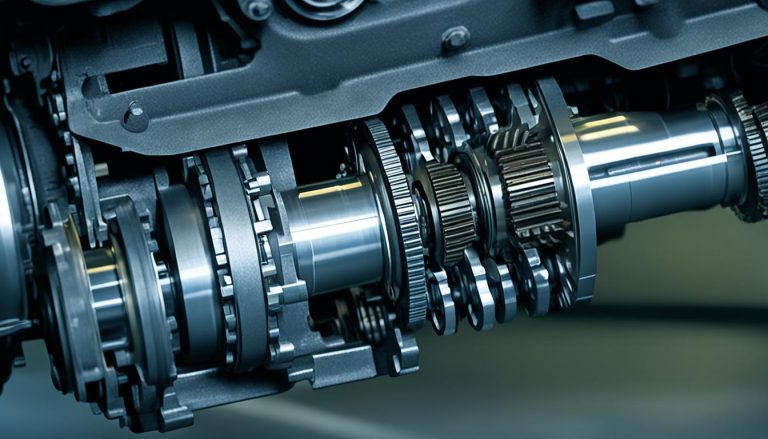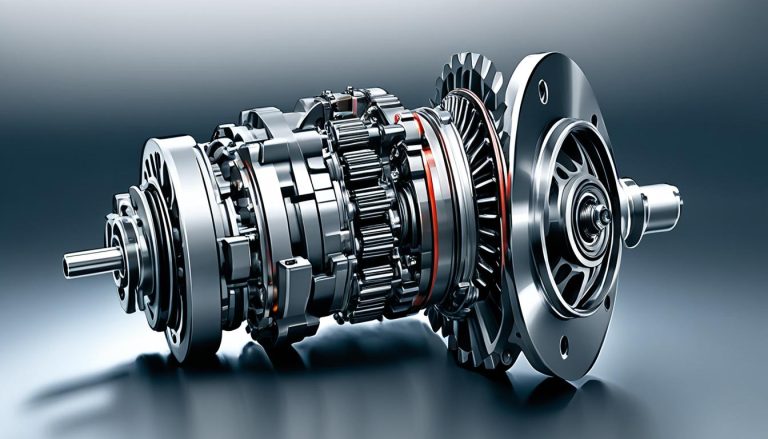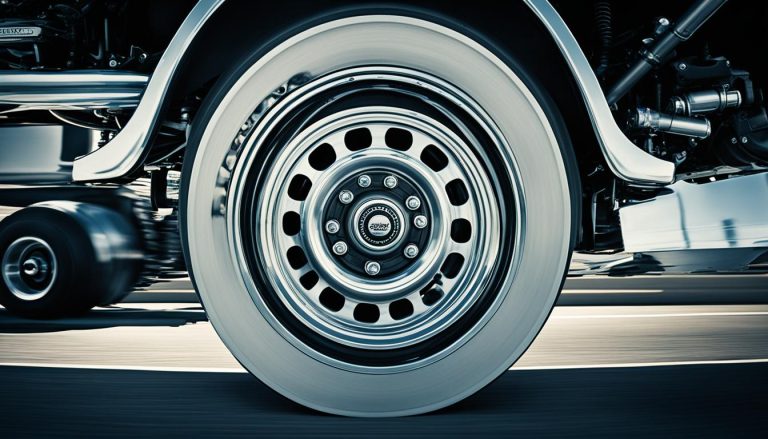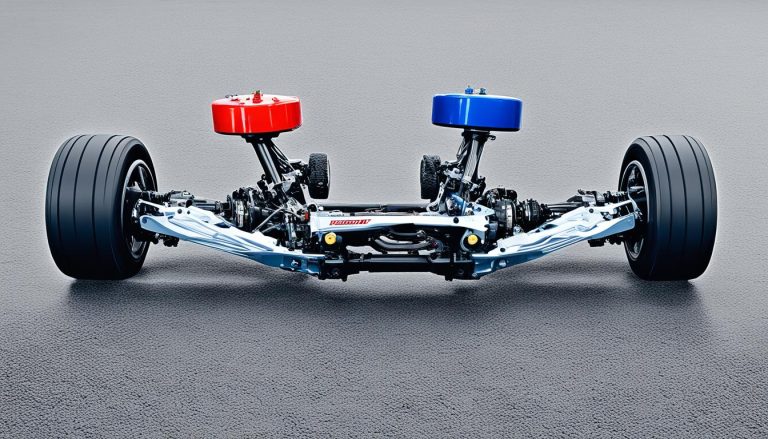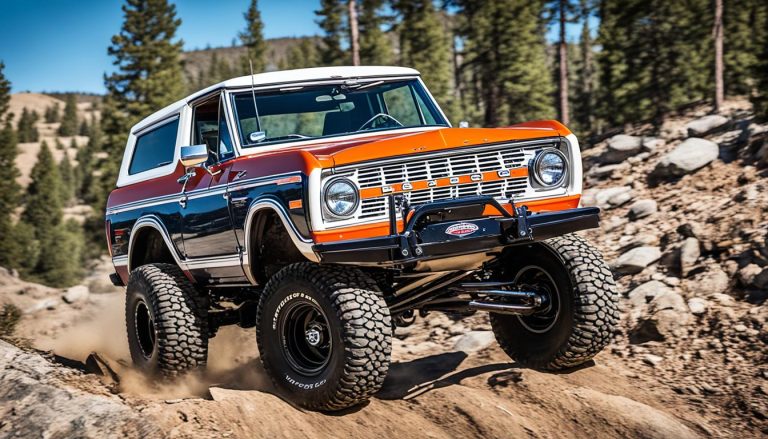Anti-Spin vs Limited Slip Differential: Compare
When it comes to your vehicle’s performance, especially in challenging conditions, the differential system is a game changer. If you’ve delved into axle options, you’ve likely come across terms like anti-spin differential rear axle and limited slip differential. Understanding these can be the key to superior handling and safety. Whether you’re traversing icy roads or rugged terrain, a well-chosen differential can ensure you stay in control. Let’s explore the critical differences and functionalities of anti-spin technology and limited slip technology to help you make an informed decision about the differential types best suited for your ride.
Key Takeaways
- Distinguishing between anti-spin differential rear axle and limited slip differential helps you understand your vehicle’s traction capabilities.
- Both differential types offer enhanced traction compared to open differentials, but with varying mechanisms and outcomes.
- The choice between anti-spin and limited slip technology can significantly impact your vehicle handling in adverse conditions.
- A proper differential system comparison is crucial for anyone looking to upgrade their axle options for better performance.
- Understanding the intricacies of differential types ensures you’re prepared for whatever the road—or off-road—throws your way.
Understanding Differential Systems in Vehicles
At the heart of your vehicle’s ability to maneuver and grip the road under various conditions is its differential system. Integral to vehicle traction management, the differential allows for differential speeds between the wheels when turning, enhancing both vehicle handling and safety. As you learn about the importance of this system, you’ll appreciate the differential’s role in performance, especially when driving on challenging terrains where traction enhancement is critical.
What Is a Differential and How Does It Work?
A rear differential is the unsung hero located in the rear axle of your rear-wheel-drive vehicles. Its primary function is to distribute the engine’s torque to the wheels. But more impressively, it allows each wheel to rotate at different speeds, especially while taking turns, when the outer wheels need to travel a longer distance than the inner wheels. This differential system essential ensures that power is sent to the wheels in a way that maximizes traction and minimizes wheel slippage.
The Role of Differentials in Traction and Handling
Differentials are paramount when it comes to vehicle handling on slick surfaces, including icy roads. Think of them as traction enhancement professionals that sprinkle a bit of expertise to your vehicle’s performance. By adjusting power distribution to the wheels, your differential works tirelessly to maintain the necessary grip for each wheel, thus avoiding the risk of tire-skidding scenarios and keeping you firmly on the road regardless of the treachery under the tires.
Let’s take a look at a brief comparison of how different vehicles might cope without the advancement of differential systems:
| Vehicle Type | Without Differential Support | With Differential Support |
|---|---|---|
| Rear-Wheel Drive | Potential one-wheel spin on turns | Even power distribution enhances grip on both wheels |
| Four-Wheel Drive | Reduced off-road capability due to limited traction management | Improved traction and handling in rugged conditions |
| All-Wheel Drive | Higher risk of wear on drivetrain components | Balanced torque delivery ensures smoother operation |
| Sports Car | Possibility of understeer or oversteer during aggressive driving | Better cornering performance and stability at high speeds |
Remember, understanding your vehicle’s differential system is not just about the mechanics; it’s about enhancing your driving experience. Whether you’re tackling a snowy path, enjoying an off-road adventure, or simply commuting, the rear differential, a gem within the rear axle, plays a pivotal role in assuring you have the control and confidence you need behind the wheel.
The Basics of Anti-Spin Differential Rear Axle
For drivers seeking superior rear axle functionality and control in challenging conditions, understanding the mechanics and advantages of the anti-spin differential is essential. This innovative technology is a key component in the enhancement of vehicle performance, especially on slippery roads.
Anti-Spin Technology and Its Operation
An anti-spin differential operates through precise mechanical engineering to ensure that your vehicle maintains positive traction capability. Typically, this system employs a series of helical gears and pinion brake shoes to manage power distribution. When a difference in wheel speed is detected—such as when one wheel loses grip on an icy surface—the differential responds by exerting a braking force via the pinion gears. This creates frictional drag on the opposing gears, thereby allocating more power to the wheel with better road contact. This mechanism lies at the heart of anti-spin differential operation, maintaining propulsion and control.
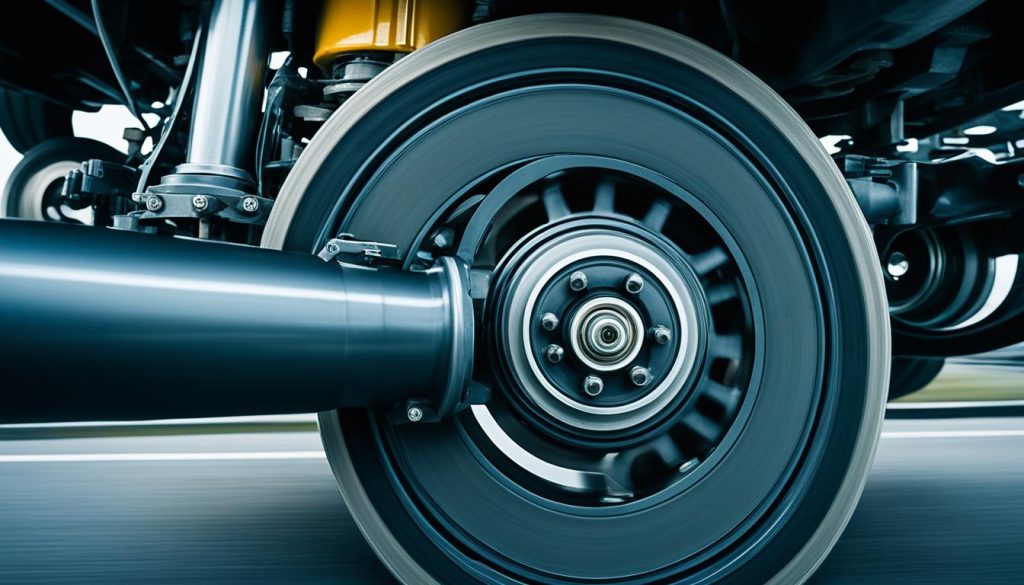
Benefits of Anti-Spin Differential in Your Vehicle
Installing an anti-spin differential introduces a wide array of benefits, transforming your vehicle’s handling and safety profile. Here’s what you can expect:
- Improved Performance on Slippery Roads: The anti-spin differential is designed to react to loss of grip on slick surfaces, aiding your vehicle in maintaining momentum and stability where traditional open differentials may falter.
- Enhanced Vehicle Control: By preventing wheel spin and promoting even power distribution to the wheels, drivers can enjoy improved handling, vital for navigating unpredictable terrain or adverse weather conditions.
- Positive Traction Capability: Regardless of the driving situation, from rain-soaked highways to snow-covered trails, the anti-spin differential ensures your tires receive the torque they need to keep you moving forward assuredly.
- Anti-Spin Differential Benefits: Overall, this technology affords drivers the peace of mind that comes with consistent performance and handling, particularly in environments where traction is compromised.
Embrace the enhanced driving experience and vehicle control with the sophisticated operation of an anti-spin differential rear axle — your companion for tackling tough road conditions gracefully.
Characteristics of Limited Slip Differential
If you’ve ever experienced wheel slip in wet or muddy conditions, understanding the characteristics of a limited slip differential (LSD) can illuminate why this vehicle performance upgrade is essential for many drivers. By employing a limited slip technology mechanism, a vehicle not only gains a differential enhancement but engenders a more responsive and safer drive.
How Limited Slip Technology Works
A limited slip differential is ingeniously designed to be torque-sensitive, meaning it can automatically detect when one wheel is spinning faster than the other—a common occurrence during a loss of traction. The heart of this system may be helical gears or clutch packs that engage to redistribute power to the wheel with more grip, thus limiting slippage and enhancing control. This automatic torque vectoring function makes LSD a crucial component for improved traction over open differentials. No manual input is needed; the mechanism intuitively responds to the driving conditions.
Advantages of Limited Slip Differential Over Open Differentials
When you’re considering upgrading your vehicle for better performance, especially under challenging conditions, the limited slip differential advantages become apparent. Here’s a closer look at these benefits:
| Traction Enhancement | Control and Stability | Performance in Inclement Weather |
|---|---|---|
| Delivers power to both wheels equally, reducing the likelihood of wheel spin. | Increased handling capabilities when cornering, as power is more effectively distributed to each wheel. | Significant improvement in handling on snow, ice, or muddy roads, offering safer driving experiences. |
| Provides consistent power delivery, which is essential for off-road activities. | Helps maintain directional control by minimizing unexpected vehicle behavior during traction loss. | Allows for better launch control in sports cars, even in wet conditions. |
| Generally offers longer lifespan than open differentials due to less wear on tires and drivetrain components. | Enhanced towing capabilities as a result of improved traction. | Offers peace of mind for everyday driving, knowing your vehicle can handle unexpected patches of ice or standing water. |
In conclusion, the allure of a limited slip differential isn’t just in its ability to upgrade vehicle performance—it’s the confidence and control it imparts to you, the driver. Whether it’s navigating off-road terrain or ensuring safety during adverse weather conditions, an LSD can be an invaluable addition to your vehicle.
The Distinct Differences Between Anti-Spin and Limited Slip Differentials
As you delve into the world of differential technology, you’ll encounter terms like anti-spin and limited slip, which are often considered functionally equivalent. However, subtle distinctions in design set these systems apart, impacting the performance of vehicles, especially in formidable conditions such as icy or muddy roads. Let’s explore what differentiates these two types of differentials and how this affects your driving experience.
Understanding these differences is pivotal in a differential comparison, especially when deciphering the nuances that contribute to the anti-spin versus limited slip debate. It’s crucial to note that these differential technology distinctions might influence your decision if you often drive in environments where traction can mean the difference between a smooth ride and a potentially tricky situation.
For example, Ram Heavy-Duty (HD) models employ a helical gear limited slip differential (LSD) that operates smoothly without the need for added fluids. Contrarily, the Ram 1500 utilizes a clutch pack-style LSD, which necessitates specific fluid additives to maintain optimal functionality. These technical variations influence the level of traction control provided under different driving scenarios.
Many drivers report experiencing a noticeable ‘thunk’ as the anti-spin system engages, offering immediate tactile feedback indicating that additional traction is being applied to maintain stability on slick surfaces.

| Feature | Anti-Spin Differential | Limited Slip Differential |
|---|---|---|
| Mechanism | Pinion gears applying frictional drag | Helical gears or clutch packs limiting slippage |
| Fluid Needs | Variable based on model; may require special additives | Typically does not require additional fluids |
| Engagement Indicator | Audible ‘thunk’ when traction is redistributed | Usually silent, seamless operation |
| Response Time | Immediate engagement for traction | Varies; some systems react quicker than others |
| Traction Performance | Excellent in conditions like snow without 4WD | Evenly distributed torque provides consistent grip |
Whether you choose an anti-spin or limited slip differential, the benefits are clear: enhanced traction, stability, and control in problematic driving conditions. Comprehending these key elements ensures you’re equipped with the knowledge to select the right differential technology for your vehicle, optimizing your road experiences no matter where life takes you.
Anti-Spin Differential Rear Axle vs Limited Slip Differential
Embarking on an off-road adventure or navigating slippery roads demands a vehicle equipped with the right differential. Understanding the nuance in off-road performance, all-terrain traction, and the longevity of your vehicle’s components can make all the difference. Let’s dive into how anti-spin and limited slip differentials stand up to these challenges, and what their maintenance requirements entail.
Performance Comparison in Various Driving Conditions
Whether you’re conquering rocky paths or facing a blanket of snow, the effectiveness of your differential system can significantly impact your driving experience. The anti-spin differential is known for aiding drivers in maintaining control without relying on four-wheel drive, making it a favorite for those who face snowy conditions regularly. In contrast, off-road enthusiasts often prefer the prompt engagement of limited slip differentials, which prove to be indispensable for instant all-terrain traction on unpredictable terrain.
Maintenance Requirements for Each Differential Type
Differential maintenance is critical to ensure component longevity, and the type of differential in your vehicle can influence the fluid change frequency. Ram 1500 models with clutch pack differentials require the occasional use of friction modifier additives to keep the differential functioning smoothly. On the other hand, Ram HD models equipped with helical gear LSDs are less demanding, sparing you the need for additives, but not the regular maintenance checks.
Staying on top of these maintenance rituals will not only enhance your off-road performance but also extend the life of your differential system.
| Differential Type | Maintenance Requirement | Recommended Fluid Change Frequency |
|---|---|---|
| Anti-Spin Differential | Regular inspection, fluid changes as per manual | 30,000-50,000 miles |
| Limited Slip Differential | Friction modifier additives & regular checks | Every 30,000 miles or as needed |
Your rigorous driving pursuits demand that you understand the capabilities and care requirements of your vehicle’s differential. Whether it’s the whisper of an anti-spin in the background or the assertive lock of a limited slip, keeping these mechanisms in check ensures you’re ready for the trail ahead. Remember, proactive differential maintenance underpins the tenacity of your off-road journeys and the reliable performance of your vehicle in every terrain.
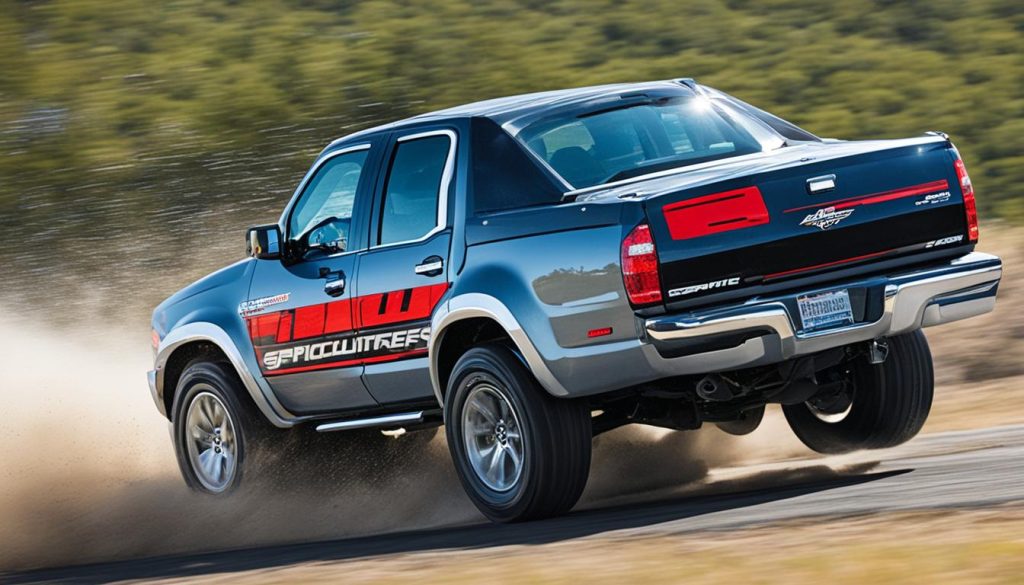
Choosing the Right Differential for Your Vehicle
When it comes to maximizing your driving experience, the differential system plays a critical role in your vehicle’s performance. Whether you’re navigating rough terrain, enduring extreme weather, or simply seeking a smoother ride, understanding the nuances of selecting the right differential system is essential. Here’s how to align your driving preferences to the optimal system and ensure you meet your traction demands adequately.
Factors to Consider When Selecting a Differential System
Your quest for the perfect differential should begin with a thorough driving conditions consideration. Reflect on the environments you’ll encounter; are they wet, icy, rocky, or uneven? Tailoring your choice to your regular driving conditions and the performance you expect will significantly affect your satisfaction. Moreover, your differential impacts fuel efficiency and tire wear, so differential decision-making should not be taken lightly.

Axle Options: Which Is Best for Your Driving Needs?
Every vehicle has its unique requirements and axle choices. Typically, rear-wheel-drive vehicles offer an open, limited slip, or anti-spin differential. Take the time to assess whether your driving scenarios demand one of these specialized systems. Perhaps your lifestyle leads you off the beaten path, or you frequent areas with severe weather — in these cases, investing in a differential that offers superior traction is a smart move. Let’s look at a comparison to help clarify your decision.
| Differential Type | Traction Enhancement | Typical Use Cases | Considerations |
|---|---|---|---|
| Open Differential | Basic | Dry roads, everyday commuting | Not suitable for high traction demands |
| Limited Slip Differential | Moderate to High | Performance driving, mild off-roading | Periodic maintenance may be required |
| Anti-Spin Differential | High | Harsh weather conditions, rigorous off-road | Higher cost, but optimal traction |
Choosing the right differential is a balance between necessity and preference. By aligning your driving preference alignment with the appropriate system, both safety and performance can be enhanced to meet your personal standards. Take your time, evaluate the options, and make an educated choice that ensures every drive aligns with your expectations of control and stability.
Real-World Applications: Off-Roading and All-Terrain Performance
For many driving enthusiasts, the ultimate test of a vehicle’s prowess is its off-road capability. The differential system a vehicle is equipped with can dramatically alter its performance over diverse terrains. Understanding the differential impact on all-terrain challenges is crucial to optimizing your driving experience. Through real-world differential application, we gain insights into which systems best align with different environments and styles of off-roading.
Let’s delve into user feedback on differentials and explore the differential preference in off-roading communities. This information can provide valuable driving impressions to guide your next adventure or vehicle modification.
The Impact of Differential Types on Off-Road Capability
Your choice in a differential determines how well your vehicle can handle and maintain traction on unpredictable surfaces. For instance, vehicles with a limited slip differential are reputed to engage more swiftly, which translates to improved traction when navigating through rocky inclines or muddy paths. The unique mechanisms that come into play prioritize wheel grip, ensuring that your journey through the great outdoors is as smooth as possible.
User Experiences with Different Differentials in Off-Roading Scenarios
Real drivers, real experiences. Those who have taken the Ram with an anti-spin differential off the beaten path report commendable performance in scenarios where others may falter—like snow-laden trails without the need for 4WD engagement. Conversely, feedback from enthusiasts using open differentials often points to the necessity for a more robust system to avoid slipping and loss of control. It’s these firsthand encounters that underscore the importance of matching the differential to the driver’s needs.
Arming yourself with knowledge about differentials will amplify your vehicle’s off-road capability and prepare you for the demands of all-terrain adventures. Whether clawing up a steep hill or traversing a rocky ravine, selecting the right differential is pivotal in ensuring that your off-road experience is thrilling, yet secure.
How to Identify Your Current Differential System
If you’re diving into the world of vehicle maintenance or simply curious about the mechanics of your car, understanding your differential system is a crucial aspect. Whether you’re navigating snowy streets or rocky terrains, having knowledge of your car’s differential—be it an anti-spin or limited slip differential—can explain much about its handling characteristics. Here’s a friendly guide on identifying differential features that could help demystify the type you have installed.
Distinguishing Features of Anti-Spin and Limited Slip Differentials
Those of you seeking to determine your vehicle’s setup might wonder about the anti-spin vs limited slip signs. An anti-spin differential typically utilizes mechanisms that lock up the wheel with less traction and direct power to the one with more grip. In contrast, a limited slip differential employs devices like clutch packs or helical gears to manage torque distribution more seamlessly. To conduct a differential examination, look for these specifics in your vehicle’s design—such as the type of gears in your axle.
Tips for Verifying Your Vehicle’s Differential Type
When it comes to verifying differential type, start with some detective work. Scrutinize the build sheet or consult the window sticker for details regarding your vehicle’s differential. For hands-on types, a more tactile approach involves jacking up the back of your car and watching how the wheels respond when spun—if they rotate in unison or opposite directions, it can indicate the type of differential. Additionally, speaking of diagnostic methods for differentials, seeking professional advice can often be a reliable avenue. If you fancy yourself a DIY enthusiast, your vehicle’s service manual could provide conclusive vehicle inspection guide content, detailing whether your system requires particular additive solutions, which is common with LSDs. Armed with these insights, you’ll be better equipped to understand the capabilities and needs of your vehicle’s differential system.
FAQ
What is the difference between an anti-spin differential and a limited slip differential?
An anti-spin differential and a limited slip differential are similar as both provide enhanced traction by evenly distributing power to both wheels, reducing wheel spin. However, they may differ slightly in design and operation depending on the vehicle model and manufacturer.
How does a differential system enhance vehicle traction and handling?
A differential system allows the wheels to turn at different speeds, which is essential for maintaining traction and handling, especially when cornering. It manages power distribution to the wheels to prevent skidding and help control the vehicle on adverse surfaces.
What are the benefits of having an anti-spin differential in a vehicle?
The benefits of an anti-spin differential include better traction control and vehicle stability, particularly on slippery roads. It helps maintain consistent performance and safety in challenging driving conditions.
How does limited slip technology work to enhance vehicle performance?
Limited slip technology uses mechanisms like torque-sensitive design with helical gears or clutch packs to sense wheel spin and redirect torque to the wheel with more grip. This helps limit wheel slippage, providing better traction and vehicle control.
Are there noticeable differences in operation between anti-spin and limited slip differentials?
Yes, drivers may notice differences in traction, response time, and engagement behavior such as a “thunk” sound when the differential activates. These differences are often model-dependent and influenced by the specific mechanisms employed.
How do driving conditions affect the performance of anti-spin and limited slip differentials?
The performance can vary significantly depending on conditions like off-road terrain, icy roads, or mud. Some drivers report immediate locker engagement and better traction with limited slip differentials, while anti-spin differentials may be highly effective in snow without engaging 4WD.
What are the maintenance requirements for different differential types?
Maintenance needs can differ, with certain types like the clutch pack differential in Ram 1500 models requiring friction modifier additives, whereas helical gear differentials may not. The maintenance schedule may also vary based on the driving conditions and differential type.
How should I choose the right differential for my vehicle?
When selecting a differential, consider your typical driving conditions, traction needs, and driving style. If you often drive off-road or in regions with difficult weather conditions, a vehicle equipped with an anti-spin or limited slip differential may offer better performance.
What impact do different differential types have on off-road capability?
The type of differential can significantly influence a vehicle’s off-road performance. Trucks with limited slip differentials may experience immediate traction improvement on uneven terrains, whereas anti-spin differentials’ effectiveness can vary based on their specific design and technology.
How can I identify if my vehicle is equipped with an anti-spin or limited slip differential?
You can consult your vehicle’s build sheet, window sticker, service manual, or check for LSD-specific additive requirements. A physical inspection, where you lift the vehicle and rotate the wheels, can also reveal the differential type based on wheel rotation behavior and visual identification of components like clutch packs or helical gears.

